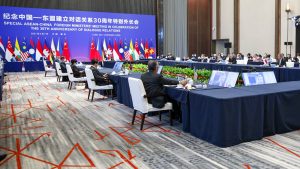The COVID-19 pandemic, the South China Sea, and the political crisis in Myanmar topped the agenda at yesterday’s Special ASEAN-China Foreign Ministers’ Meeting in the southwestern Chinese city of Chongqing.
On June 7, foreign ministers from the ASEAN states met for talks with their Chinese counterpart Wang Yi, against a backdrop of intensifying rivalry between Beijing and Washington in the Asia-Pacific. Unsurprisingly, COVID-19 was an important subject of discussion, given the fact that most Southeast Asian nations are struggling with rising caseloads and shortages of vaccines. As if to illustrate the severity of the situation, Malaysia’s Foreign Minister Hishammuddin Hussein was forced to cancel his trip just hours before his departure to Chongqing to enter mandatory COVID-19 quarantine.
Speaking to reporters after yesterday’s meeting, Indonesian Foreign Minister Retno Marsudi took the opportunity to call for more vaccine cooperation between the region and China, now that both the Sinopharm and Sinovac inoculations have been added to the World Health Organization’s emergency-use list. She warned that the “global vaccines gap risks prolonging the pandemic, including in Southeast Asia.”
Singapore’s Foreign Minister Vivian Balakrishnan said after the meeting that the ministers highlighted the “very effective” cooperation between ASEAN and China in battling COVID-19, pointing to China’s provision of essential medical supplies in the early period of the pandemic, and its more recent donations of vaccines to nearly every member of ASEAN. “The fact that we were able to help each other at the point in need built confidence and bodes well for the future,” he said.
Another big issue tackled during the meeting was the ongoing crisis in Myanmar. The foreign ministers of Singapore, Indonesia, and Malaysia jointly expressed their disappointment that Myanmar’s military junta has done little to implement the “five-point consensus” agreed by ASEAN leaders at a special summit in Jakarta on April 24, which included junta leader Sen. Gen. Min Aung Hlaing.
The five-point consensus included calls for the cessation of violence, peaceful dialogue, and the appointment of a special envoy, but the junta has dragged its feet, claiming that it will only cooperate with ASEAN once it has attained “the stability and security of the country.”
Malaysia’s Hishammuddin wrote on Twitter that developments have been “painfully slow,” while Balakrishnan expressed his disappointment “at the slow – very, very slow progress.” Indonesia’s Retno said after the meeting that ASEAN desired China’s help in carrying out its consensus. “China’s support to ASEAN to follow up on the five-points of consensus will be highly appreciated, because this will contribute to efforts to reach a peaceful solution to the crisis,” she said.
The Special ASEAN-China Foreign Ministers’ Meeting, intended to mark this year’s 30th anniversary of ASEAN-China Dialogue Relations, takes place against the backdrop of intensifying diplomatic efforts by the U.S. to rally regional support for its goal of curbing Chinese power and ambition.
Amid the protracted transition from the Trump to Biden administrations, China launched a flurry of diplomatic exchanges with Southeast Asia, which have seen Wang Yi visit nine of the 10 ASEAN countries since October, and four Southeast Asian foreign ministers visit China in late March and early April.
This contrasts with the limited recent outreach of the Biden administration, which in its Asian diplomacy has so far prioritized engagements with its Quad partners: Australia, India, and Japan. Deputy Secretary of State Wendy Sherman did pay visits to three Southeast Asian capitals last week, but a planned May 25 video call between Secretary of State Antony Blinken and ASEAN foreign ministers fell through after Blinken experienced technical difficulties. (Symbolically, he was en route to the Middle East at the time.) At the same time, because of bottlenecks in the confirmation of candidates, the United States currently has no serving ambassadors in half of the ASEAN countries, in addition to ASEAN itself.
As I’ve argued before, Beijing’s greater engagement with Southeast Asia reflects the simple fact that the region is closer to China than the U.S., and is thus more central to its core national interests, while the U.S. quite reasonably views its Quad partners in much the same way. This has been the subtext to much of Beijing’s recent engagement with Southeast Asia, which has sought to underline the fact of China’s proximity and its centrality to the region’s recovery from both the public health and economic impacts of COVID-19, in contrast with the episodic nature of U.S. engagements.
But close and constant engagement is no firm guarantee of good relations, and the tension in China’s approach to the region was evident in the discussion of the long-awaited and elusive Code of Conduct (COC) for the South China Sea. Talks have inched forward for years, but like much else, came to a halt altogether during the pandemic. But what steps have taken place have been shadowed by China’s recent assertive actions in the South China Sea.
Most recently, Chinese military aircraft entered Malaysia’s maritime zone airspace on May 31, prompting Kuala Lumpur to scramble its jets in response. Hishamuddin later described the Chinese action as an “intrusion” and summoned the Chinese ambassador to complain about this “breach of the Malaysian airspace and sovereignty.”
This recent “buzzing” of Malaysian airspace, coming after years of similar episodes in disputed parts of the South China Sea, raises suspicions that the COC is simply Beijing’s way of buying diplomatic time while its growing military power establishes its de facto control over the waterway, while economic reliance on China makes it hard for Southeast Asian nations to protest or resist. All of this suggests that most of the region’s governments will quietly welcome increased U.S. engagement with the region, if and when it comes.
































